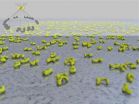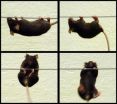Diet may not impact certain health outcomes in older persons
2013-01-15
(Press-News.org) UNIVERSITY PARK, Pa. -- Eating diets high in sugar and fat may not affect the health outcomes of older adults ages 75 and up, suggesting that placing people of such advanced age on overly restrictive diets to treat their excess weight or other conditions may have little benefit, according to researchers at Penn State and Geisinger Healthcare System.
"Historically people thought of older persons as tiny and frail," said Gordon Jensen, head of the Department of Nutritional Sciences at Penn State, "but that paradigm has changed for many older persons. Currently, 30 percent or more may be overweight, and by 2030, almost 30 percent are projected to be obese, not just overweight. Recent reports even suggest that there may be survival benefits associated with overweight and mild obesity status among the elderly."
"We all know that adverse dietary patterns, such as a Western diet containing high amounts of fat or a diet containing high amounts of refined sugar, both of which may contribute to obesity, are associated with adverse medical conditions and health outcomes for many people, but until now, the health effects of these types of poor diets have not been characterized for people who live to 75 years of age and older," said Pao Ying Hsao, postdoctoral fellow at Penn State.
The team's research is part of a decades-long collaborative study between Penn State and the Geisinger Healthcare System on the effects of nutritional status and diet on the health of more than 20,000 older people living in Pennsylvania. In the current study, the team followed 449 individuals for five years who were on average 76.5 years old at the beginning of the study.
"This is one of the first studies to examine obesity-related health outcomes and dietary patterns in such aged persons," Jensen said.
At study baseline, the team assessed the participants' dietary patterns by calling each of them by telephone four or five times during a 10-month period and asking them about their diets over the previous 24 hours. The participants were categorized as adhering to one of three different dietary patterns. The "sweets and dairy" pattern was characterized by the largest proportions of energy from baked goods, milk, sweetened coffee and tea and dairy-based desserts, and the lowest intakes of poultry. The "health-conscious" pattern was characterized by relatively higher intakes of pasta, noodles, rice, whole fruit, poultry, nuts, fish and vegetables, and lower intakes of fried vegetables, processed meats and soft drinks. The "Western" pattern was characterized by higher intakes of bread, eggs, fats, fried vegetables, alcohol and soft drinks, and the lowest intakes of milk and whole fruit.
Using outpatient electronic medical records, the researchers identified whether the participants developed cardiovascular disease, diabetes mellitus, hypertension (high blood pressure) and metabolic syndrome during the five-year period. They found no relationship between dietary pattern and prevalence of cardiovascular disease, diabetes, metabolic syndrome or mortality in the participants; however, they did find an increased risk of hypertension in people who followed the "sweets and dairy" pattern.
The results appeared in this month's issue of the Journal of Nutrition Health and Aging.
"We don't know if the participants had been following these dietary patterns their entire adult lives, but we suspect they had been because people don't usually change dietary practices all that much," Jensen said. "The results suggest that if you live to be this old, then there may be little to support the use of overly restrictive dietary prescriptions, especially where food intake may already be inadequate. However, people who live on prudent diets all their lives are likely to have better health outcomes."
###
The United States Department of Agriculture's Agricultural Research Service funded this work. Other authors on the paper include Diane Mitchell, researcher in nutritional sciences at Penn State; Donna Coffman, research assistant professor of health and human development at Penn State; Terryl Hartman, professor of nutrition at Penn State; and G. Craig Wood and Christopher Still of Geisinger Healthcare System.
ELSE PRESS RELEASES FROM THIS DATE:
Will changes in climate wipe out mammals in Arctic and sub-Arctic areas?
2013-01-15
The climate changes depicted by climatologists up to the year 2080 will benefit most mammals that live in northern Europe's Arctic and sub-Arctic land areas today if they are able to reach their new climatic ranges. This is the conclusion drawn by ecologists at Umeå University in a recently published article in the journal Plos ONE.
The scientists Anouschka Hof, Roland Jansson, and Christer Nilsson of the Department of Ecology and Environmental Science at Umeå University investigated how future climate changes may come to impact mammals in northern Europe's Arctic and ...
Generic HIV treatment strategy could save nearly $1 billion annually but may be less effective
2013-01-15
NEW YORK (Jan. 14, 2013) -- Replacing the combination of brand-name, antiretroviral drugs currently recommended for control of HIV infection with soon-to-be-available generic medications could save the U.S. health care system almost $1 billion a year but may diminish the effectiveness of HIV treatment. A study led by Massachusetts General Hospital (MGH) and Weill Cornell Medical College investigators, appearing in the January 15 Annals of Internal Medicine, examines the potential impact of such a change.
"The switch from branded to generic antiretrovirals would place ...
Scientists discover structure of protein essential for quality control, nerve function
2013-01-15
LA JOLLA, CA – January 14, 2013 – Using an innovative approach, scientists at The Scripps Research Institute (TSRI) have determined the structure of Ltn1, a recently discovered "quality-control" protein that is found in the cells of all plants, fungi and animals.
Ltn1 appears to be essential for keeping cells' protein-making machinery working smoothly. It may also be relevant to human neurodegenerative diseases, for an Ltn1 mutation in mice leads to a motor-neuron disease resembling amyotrophic lateral sclerosis (ALS, also known as Lou Gehrig's disease).
"To better ...
CU-led study shows pine beetle outbreak buffers watersheds from nitrate pollution
2013-01-15
A research team involving several scientists from the University of Colorado Boulder has found an unexpected silver lining in the devastating pine beetle outbreaks ravaging the West: Such events do not harm water quality in adjacent streams as scientists had previously believed.
According to CU-Boulder team member Professor William Lewis, the new study shows that smaller trees and other vegetation that survive pine beetle invasions along waterways increase their uptake of nitrate, a common disturbance-related pollutant. While logging or damaging storms can drive stream ...
Supplements and cow's milk play biggest roles in determining vitamin D levels in children
2013-01-15
TORONTO, Jan 14, 2013—Taking a vitamin D supplement and drinking cow's milk are the two most important factors that determine how much vitamin D is in a child's body, new research has found.
Those factors play a bigger role than even skin colour and exposure to the sun, according to Dr. Jonathon Maguire, a researcher and pediatrician at St. Michael's Hospital.
"Early childhood is a critical stage in human development, so achieving and maintaining optimal vitamin D levels in early childhood may be important to health outcomes in later childhood and adulthood," Dr. Maguire ...
NASA sees strength in newborn Tropical Cyclone Emang
2013-01-15
Tropical Cyclone Emang developed in the Southern Indian Ocean on Sunday, Jan. 13 about 525 nautical miles east-southeast of Diego Garcia. At that time, infrared satellite imagery revealed that the low level circulation center was partially exposed to outer winds, and there was a burst of thunderstorm development over the northwestern quadrant.
NASA's Tropical Rainfall Measuring Mission (TRMM) satellite captured rainfall rates in Tropical Storm Narelle on Jan. 13 at 0907 UTC (5:07 a.m. EST). Moderate and heavy rainfall was occurring around the center of circulation, where ...
New sunspots producing space weather
2013-01-15
On Jan. 13, 2013, at 2:24 a.m. EST, the sun erupted with an Earth-directed coronal mass ejection or CME. Not to be confused with a solar flare, a CME is a solar phenomenon that can send solar particles into space and reach Earth one to three days later.
Experimental NASA research models, based on observations from the Solar Terrestrial Relations Observatory (STEREO) and the ESA/NASA mission the Solar and Heliospheric Observatory, show that the CME left the sun at speeds of 275 miles per second. This is a fairly typical speed for CMEs, though much slower than the fastest ...
Patient expectations of acute bronchitis not consistent with the best evidence
2013-01-15
Athens, Ga. – New research from the University of Georgia exposes a large discrepancy in the length of time patients expect an acute cough illness, also called acute bronchitis, to last and the reality of the illness. This mismatch may be a factor in the over-prescription of antibiotics.
Examining the gap in patient expectations and the actual length of time the body takes to rid itself of a chest cold, Dr. Mark Ebell, associate professor of epidemiology in the UGA College of Public Health, recently published an article in the Annals of Family Medicine. His results show ...
Tamoxifen ameliorates symptoms of Duchenne muscular dystrophy
2013-01-15
Philadelphia, PA, January 15, 2013 – A new study has found that tamoxifen, a well-known breast cancer drug, can counteract some pathologic features in a mouse model of Duchenne muscular dystrophy (DMD). At present, no treatment is known to produce long-term improvement of the symptoms in boys with DMD, a debilitating muscular disorder that is characterized by progressive muscle wasting, respiratory and cardiac impairments, paralysis, and premature death. This study will be published in the February 2013 issue of The American Journal of Pathology.
Using the mdx5Cv mouse ...
Low birth weight not associated with asthma risk
2013-01-15
ARLINGTON HEIGHTS, Ill. (January 15, 2012) – Asthma is a serious condition that affects more than 25.7 million Americans, and is responsible for nearly 4,000 deaths annually. While the cause of asthma remains unknown, a study released today in the January issue of Annals of Allergy, Asthma and Immunology, the scientific journal of the American College of Allergy, Asthma and Immunology (ACAAI), has concluded that low birth weight is not associated with asthma risk in young children.
"Asthma is the most common chronic illness in childhood and is a leading reason for missed ...




